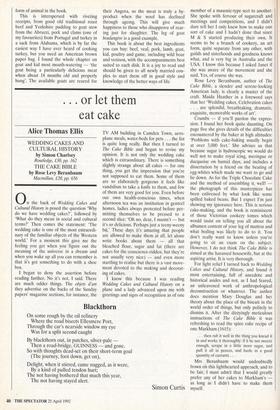Meat for a treat . . .
Jennifer Paterson
THE REAL MEAT COOKBOOK by Frances Bissell Chatto, £18.99, pp.384 This very handsome book is a modern- day Bible for meat-eaters, and also for people who have given up eating meat in protest against the rearing, feeding and slaughtering of animals, not to mention the lack of taste produced by high-tech produc- tion. Here you will find detailed descrip- tions of how good meat is raised, from its very conception, through rearing in good farms and happy pastures with every effort not to distress the animals even when slaughter time comes around. Terrible tales of overcrowding, trampling to death, tail- biting in pigs are part and parcel of the modern intensive rearing of animals. This all leads to bacteria, and the animals hav- ing to be propped up by frequent use of antibiotics and curative drugs. No wonder they taste peculiar.
Good free-range pork smells quite differ- ent from the intensive version; it will also produce proper crackling. It is interesting to note that in the very good chapter on pork Miss Bissell forbids that the rind, which should be cut in parallel lines down into the fat, should ever be basted or come into contact with any fat, liquid or juices in the roasting tin. If it does, it turns into leather, which I am sure we all remember trying vainly to chew.
There are various chapters on 'Where- to find real meat', 'Who sets the standards', `The supermarkets' and their supplies of organic products — or not, as the case may be. All very interesting. Of course, natural- ly raised animals end up being more expen- sive, but, as Miss Bissell points out, surely it is better to have fewer meals with really delicious meat and consider it a treat than constant poor and tasteless dishes coming round day after day. Also, the cattle and poultry living a stress-free life, eating a nat- ural- diet, will lay down less saturated fat and more polyunsaturated fat, which should please everybody. The message is clear: not more meat but better meat.
Apart from all this fascinating informa- tion there are very good instructions on the buying and storing of meat, the hygienic handling, cooking and carving of real meat, with excellent illustrations making it clear and simple, from carving a leg of lamb to skinning and jointing a hare or rabbit. There are lists of cuts, maps of meat from the different parts of the beasts, the correct hanging for game, the preparation of offal and the various roasting times for every
Diagram from The Real Meat Cookbook, showing the various cuts of beef
form of animal in the book.
This is interspersed with riveting receipts, from good old traditional roast beef and Yorkshire pudding to goat stew from the Abruzzi, pork and clams (one of my favourites) from Portugal and turkey in a sack from Alabama, which is by far the easiest way I have ever heard of cooking turkey, but you need an American brown paper bag. I found the whole chapter on goat and kid most mouth-watering — 'the goat being a particularly delicious meat when about 18 months old and properly hung'. The available goats are reared for their Angora, so the meat is truly a by- product when the wool has declined through ageing. This will give much happiness to those who disapprove of rear- ing just for slaughter. The leg of goat boulangere is a good example.
This book is about the best ingredients you can buy: beef, veal, pork, lamb, goat, kid, poultry and game, including wild boar and venison, with the accompaniments best suited to each dish. It is a joy to read and should be given to all newly married cou- ples to start them off in good style and knowledge of the better ways of life.



























































 Previous page
Previous page